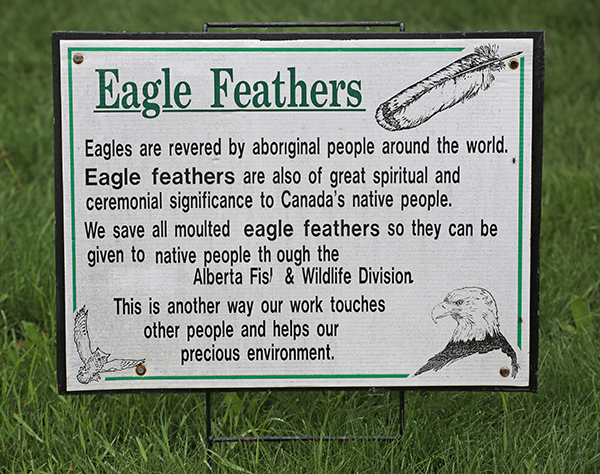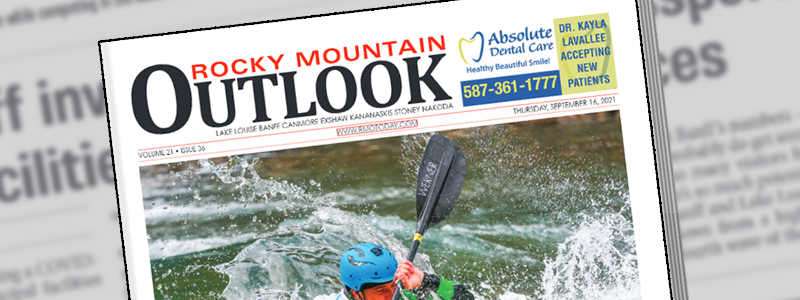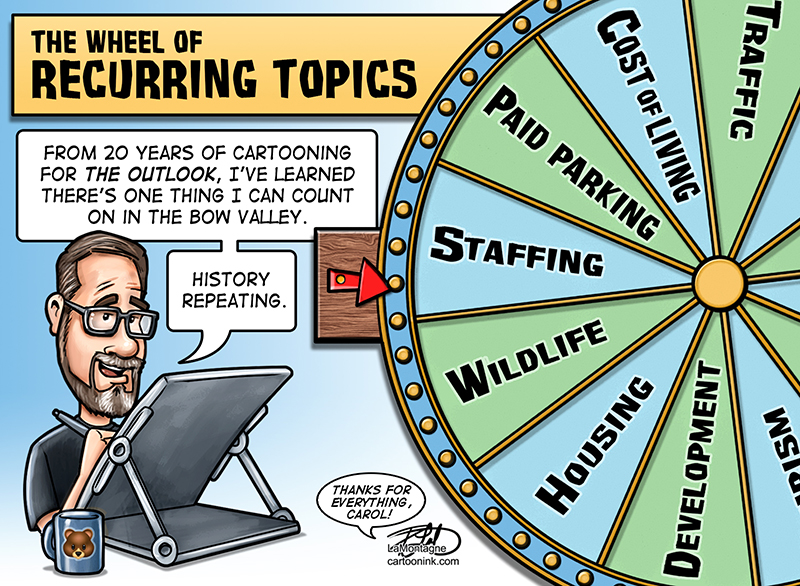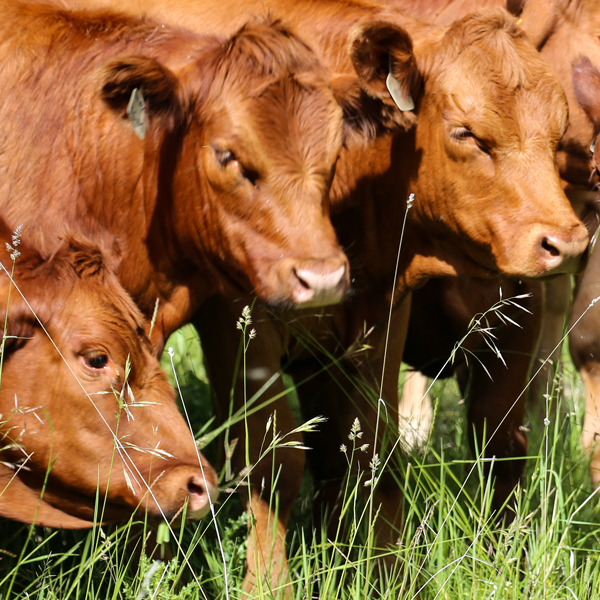
 When people talk about art for a living, they usually mean the highlights—the big launches, the finished pieces, the stuff that looks good on a timeline. But this—the half-finished paintings, the licensing negotiations, the time made for ideas—this is the work.
When people talk about art for a living, they usually mean the highlights—the big launches, the finished pieces, the stuff that looks good on a timeline. But this—the half-finished paintings, the licensing negotiations, the time made for ideas—this is the work.
If you go through any videos, articles, or books about art promotion, you’ll find one consistent theme—be consistent.
It’s easy to promise yourself you’ll write and send a post each week on the same day. Actually doing it? That’s another story.
I’ve been meeting editorial cartoon deadlines every week for more than twenty years. Coming up with ideas isn’t as tough as it used to be, but I still have to draw and send a cartoon, no matter what—whether I’m feeling inspired or not, whether I like the idea or think it’s a dud.
Even though I usually write two or three blog posts and emails each month, there are times when I don’t have much to say. And when that happens, it’s easy to think, “I’ll get to it next week.”
But that kind of procrastination isn’t fair to everyone who’s signed up for this subscription ride, and I don’t take that for granted.
So, with lots in progress but nothing quite finished to share, here’s a bit of a dog’s breakfast of what’s on my desk and on deck.
PAINTINGS
I’m still working on those three cats. That’s normal for commissions—they take time, especially when you’re trying to capture three distinct animals in one piece. But I’ve finally found my groove this week, the fun part.
Thanks to some helpful (and welcome) suggestions from the client, their personalities are coming through. There are two black cats in the painting, each with a different look and vibe, and I was a little worried about pulling that off. That’s where back-and-forth with the client really matters. The more I learn about their features and quirks, the better job I can do.
The cats are now in the same painting rather than separate sketches, and when I open the file now, I don’t clench my teeth. I smile. That’s a good feeling. It’s not unique to this commission either. That’s the usual experience for most of my paintings.
I’m also working on a snowy owl, a grizzly bear, and a raven, all at various stages of completion. There’s a lot more work to do on this one, as I’m also recording the process on video, but here’s a sneak peek at the owl in progress.
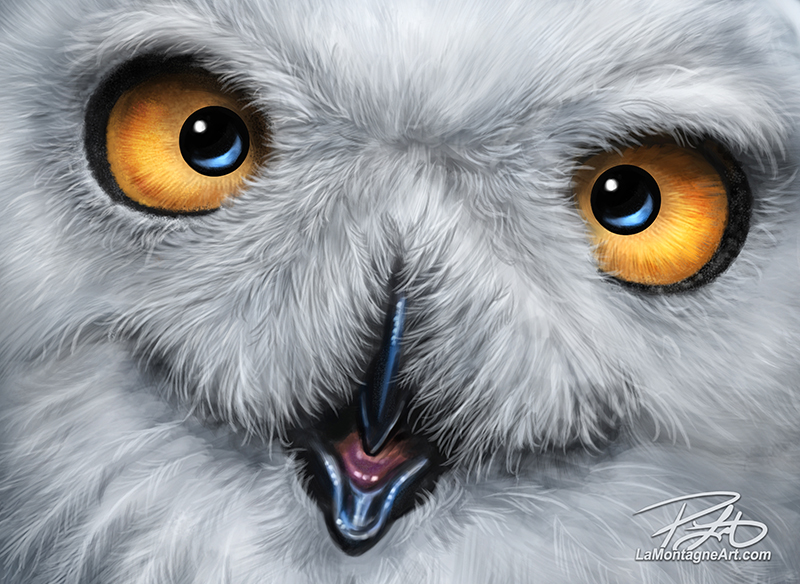
LICENSING
It’s been a good couple of weeks on the licensing front. One international company I’ve worked with before came back with a new proposal. Since my first experience with them was pretty close to perfect, I was happy to jump into a new contract with them.
Another company I’d never heard of cold-called me with a very appealing offer to license my work. We’re in the “crossing t’s and dotting i’s” stage now.
Both companies are seasoned pros when it comes to working with artists. There’s nothing unexpected in the contracts, and most of it is just formality. In my experience, that’s typical. While it does happen, it’s rare to come across a company trying to screw you over.
I realize both of these updates probably sound like teases, but that’s the nature of licensing. I can’t talk about names or details until they launch, which could take weeks, months, or even a year. In the meantime, there’s work to do behind the scenes and it takes real time and effort.
The admin side of being a professional artist often eats up more time than most expect. But licensing is a solid revenue stream because it’s built on artwork I’ve already created, and it works well for me.
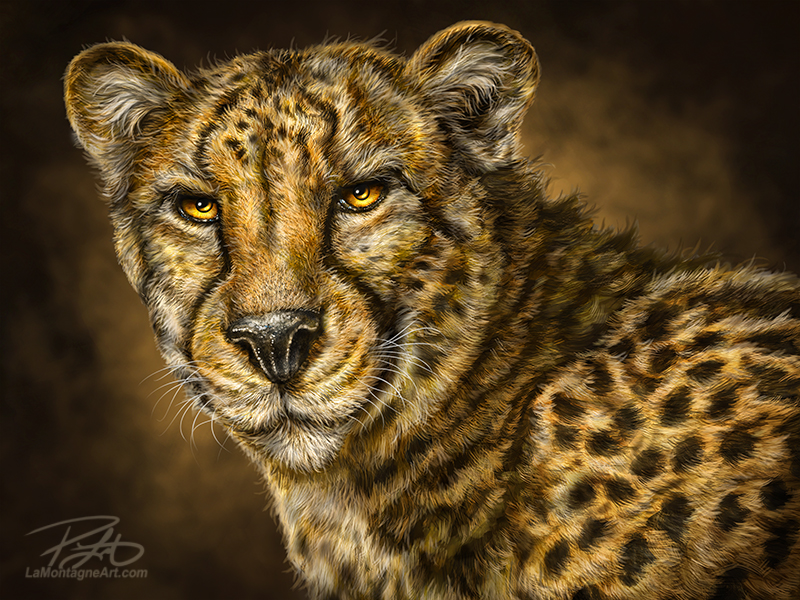 Diamond Art Club just released a new kit featuring my cheetah painting, my sixth kit so far. That one was a surprise, since it’s not one of my more popular prints. But they do plenty of research before launching a new image, and there was a demand for this one. I love working with this company, and there are more pieces in the pipeline. But they decide and let me know when I can share them.
Diamond Art Club just released a new kit featuring my cheetah painting, my sixth kit so far. That one was a surprise, since it’s not one of my more popular prints. But they do plenty of research before launching a new image, and there was a demand for this one. I love working with this company, and there are more pieces in the pipeline. But they decide and let me know when I can share them.
EDITORIAL CARTOONING
A Calgary Herald reader saw one of my recent G7 cartoons and ordered a couple of prints. I don’t get a ton of editorial cartoon orders, but enough that I’ve built a good production system for them. I use the same printer who produces my metal and canvas prints, so the quality is always spot-on.
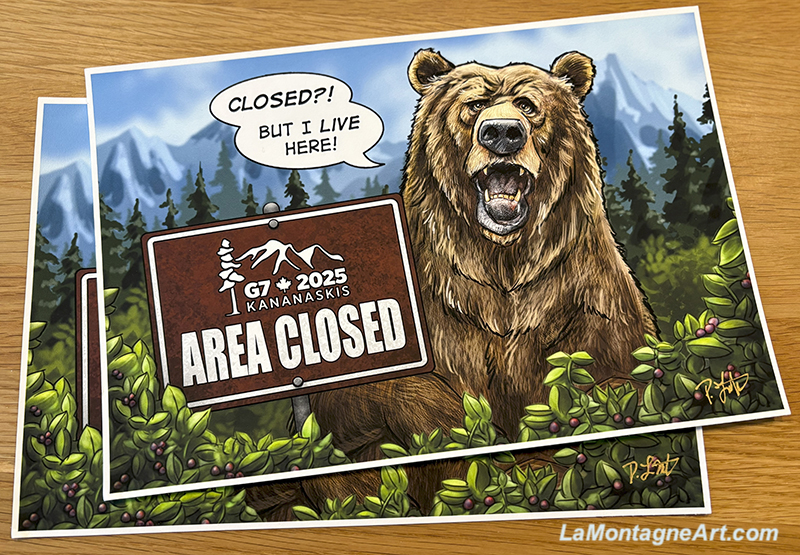 This particular cartoon also featured a grizzly bear—so the best of both worlds. I signed both prints and shipped them yesterday.
This particular cartoon also featured a grizzly bear—so the best of both worlds. I signed both prints and shipped them yesterday.
LIFE STUFF
Last weekend, I got away for a cabin trip with my buddy Darrel. It’s a good thing we book these months in advance—if I didn’t have the commitment (and the deposit), I’d probably find a too-busy excuse not to go. I know, wrong priorities, I’m working on it. Thankfully, once I’m there, it always feels like the right decision.
After years of getting up at 5:00 a.m., I can’t really sleep late anymore. Even without an alarm, and staying up later than usual, I was still up by 6 or 7. I tiptoed past Darrel’s room, showered, made some coffee to-go, and headed out looking for wildlife.

The morning walks were a peaceful start to the day. Critter sightings were limited—just some skittish white-tailed deer, a juvenile Cooper’s Hawk overhead, and cows. Lots of little birds singing in the trees, over a dozen species according to the Merlin app. One evening, a couple of Great Horned Owls were calling to each other. And in the middle of the night, coyotes howled from all directions. That last one is one of my favourite sounds in nature.
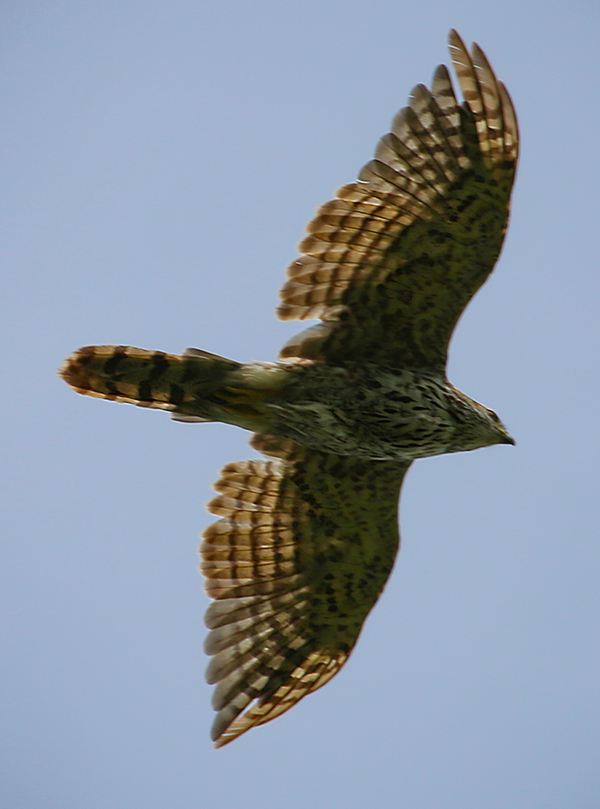 I’m always surprised when I sort through reference photos, because often something I thought I had, doesn’t look as good when I get home. And then a random throwaway photo might spark a painting.
I’m always surprised when I sort through reference photos, because often something I thought I had, doesn’t look as good when I get home. And then a random throwaway photo might spark a painting.
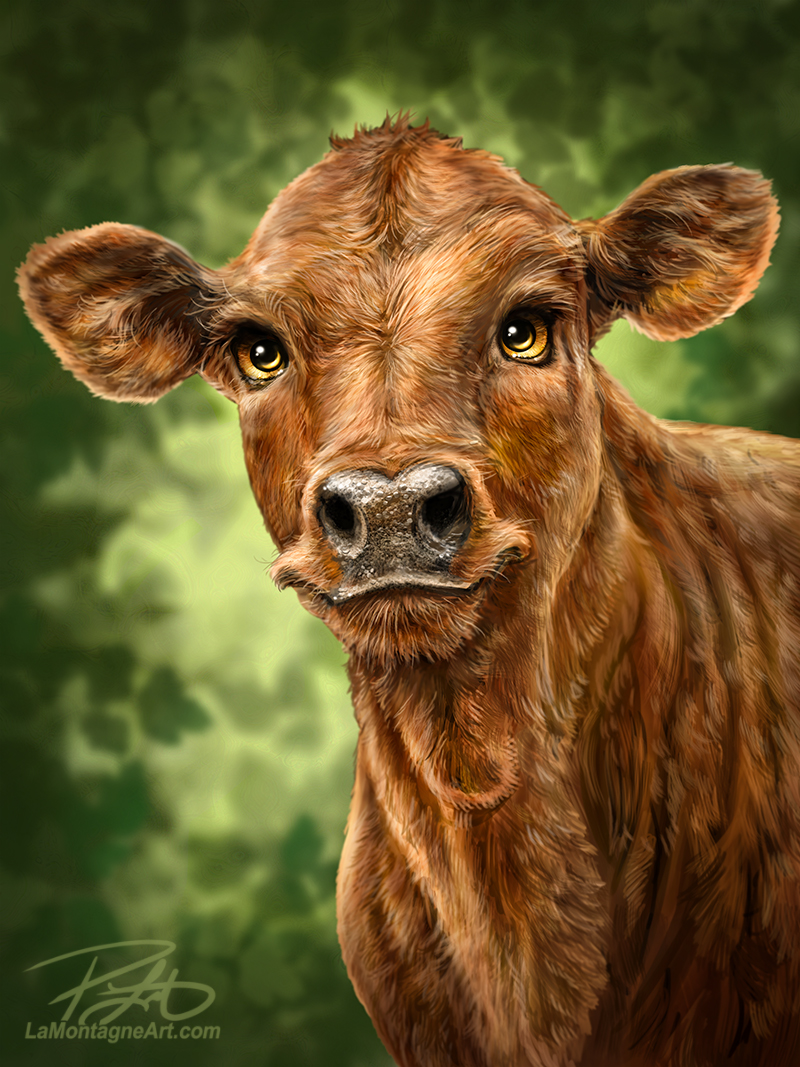 This little calf was painted from reference I took at the cabin a few years ago. I’ve since retired it because frankly it wasn’t popular, even though I enjoyed the work and like the painting. That happens a lot, where my favourites may not be your favourites.
This little calf was painted from reference I took at the cabin a few years ago. I’ve since retired it because frankly it wasn’t popular, even though I enjoyed the work and like the painting. That happens a lot, where my favourites may not be your favourites.
 But one evening on this visit, I noticed the neighbour’s cows hanging around his gate near the road, and shortly after this first pic, they clustered together and it struck me comical. So I took a bunch of photos, and though I’d work from several of the ones I shot, I think there’s a painting here. Already thinking about how long it would take, but this is a marathon, not a sprint.
But one evening on this visit, I noticed the neighbour’s cows hanging around his gate near the road, and shortly after this first pic, they clustered together and it struck me comical. So I took a bunch of photos, and though I’d work from several of the ones I shot, I think there’s a painting here. Already thinking about how long it would take, but this is a marathon, not a sprint.
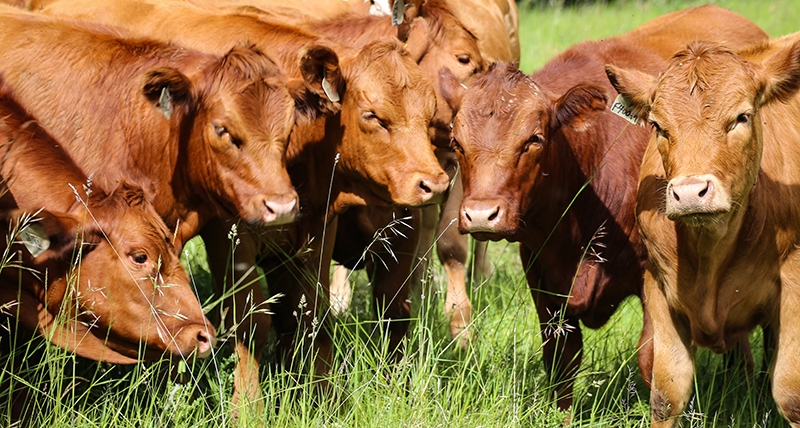 I’ll have to let it simmer a bit, but whenever I hear that voice whisper, “hey, look here,” I try to pay attention.
I’ll have to let it simmer a bit, but whenever I hear that voice whisper, “hey, look here,” I try to pay attention.
We did our usual: cards, games, guitar, napping on the deck, and wandering the property without agenda. We had some (always welcome) on-and-off rain, a loud, windy thunderstorm with a bit of non-damaging hail, but overall, the weather was pleasant.
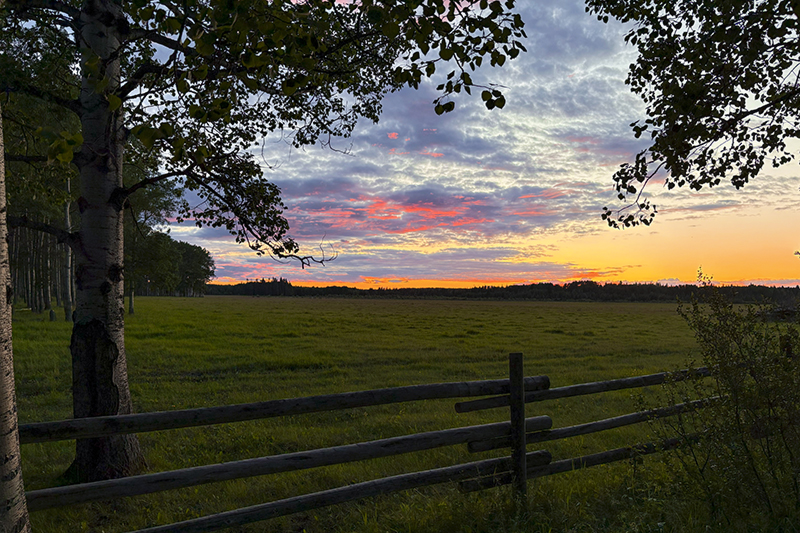 And while I still spent too much time in my own head, thinking about work and worrying about things I can’t control, the setting and company helped me turn down the volume for a few days.
And while I still spent too much time in my own head, thinking about work and worrying about things I can’t control, the setting and company helped me turn down the volume for a few days.
I’ll have some new work to share with you soon.



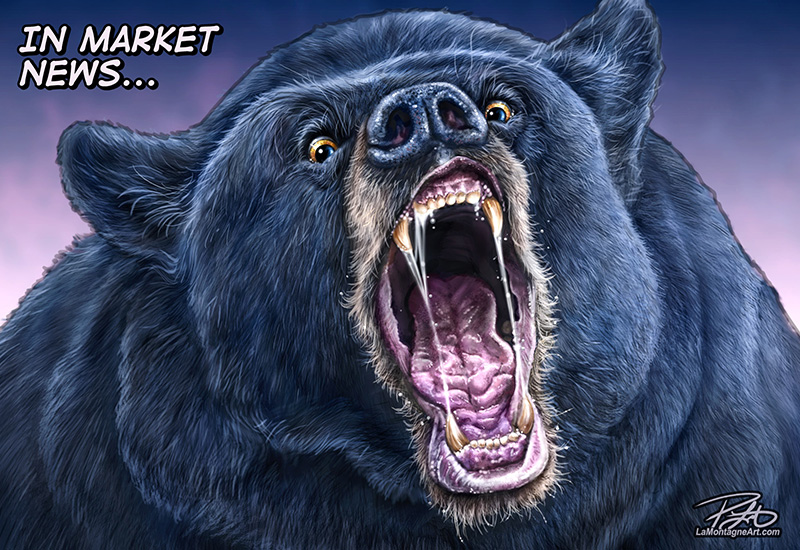 I’ve used a polar bear or two in cartoons about climate change. And when Kevin Costner was the parade marshal for the Calgary Stampede in 2022, I used my portrait of his Yellowstone character, John Dutton, in a cartoon.
I’ve used a polar bear or two in cartoons about climate change. And when Kevin Costner was the parade marshal for the Calgary Stampede in 2022, I used my portrait of his Yellowstone character, John Dutton, in a cartoon.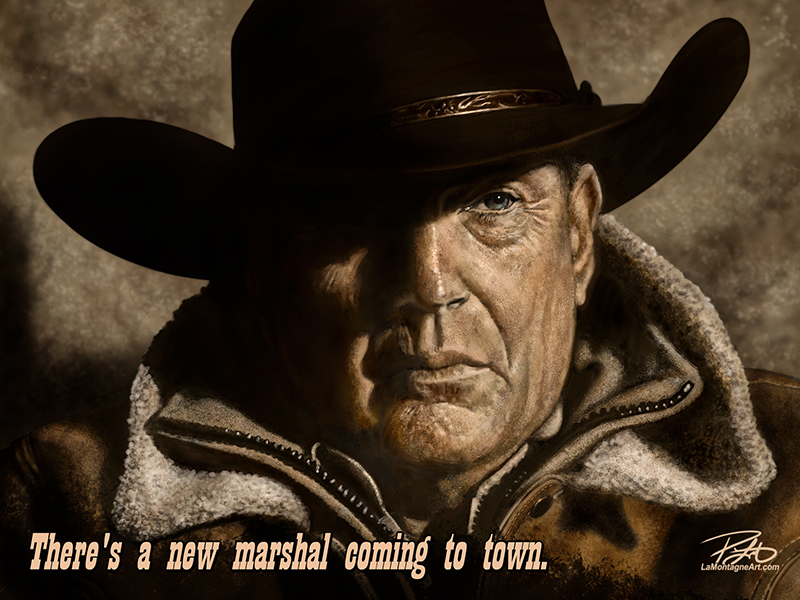 The Calgary Herald currently runs my cartoons more than any other daily newspaper in Canada, and they’ve been publishing my work for more than twenty years. How often, depends on how the editor of the day feels about my work in general. Everyone has their favourite artists.
The Calgary Herald currently runs my cartoons more than any other daily newspaper in Canada, and they’ve been publishing my work for more than twenty years. How often, depends on how the editor of the day feels about my work in general. Everyone has their favourite artists.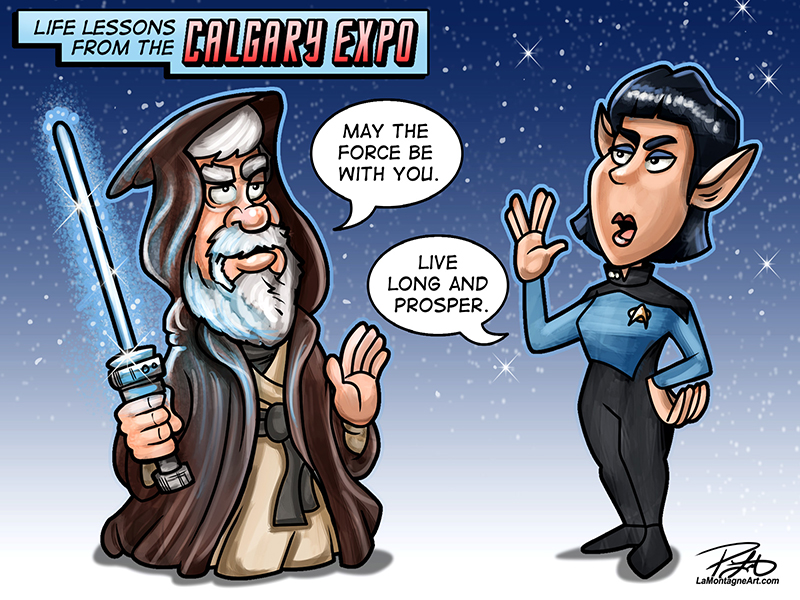
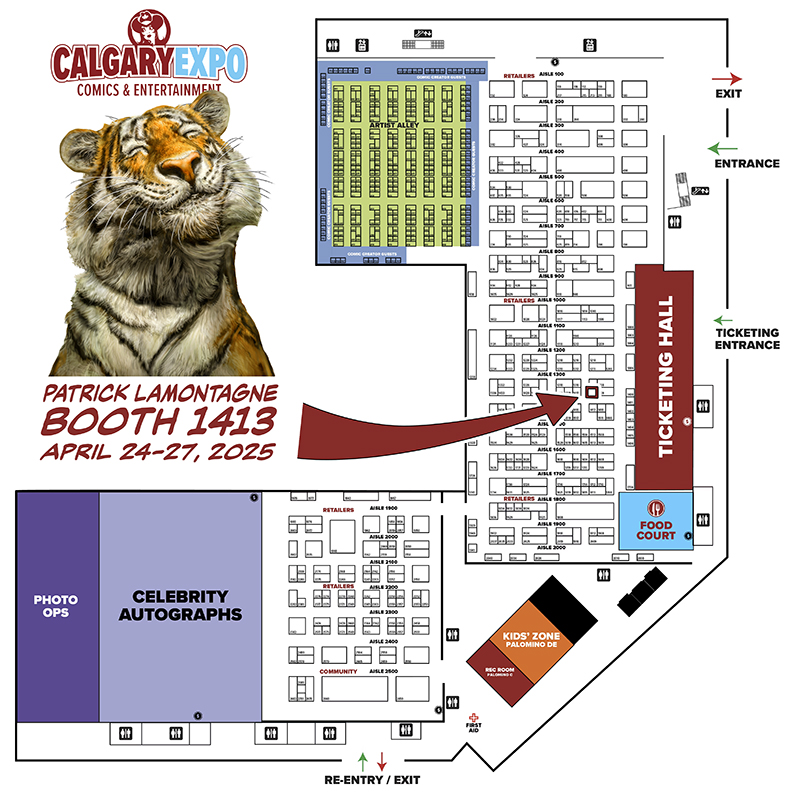 If you’re coming to the Calgary Expo, I’ll be chained to my booth from opening Thursday to closing on Sunday. I set it up yesterday, and I’m ready for the chaos. Come by and say Hello!
If you’re coming to the Calgary Expo, I’ll be chained to my booth from opening Thursday to closing on Sunday. I set it up yesterday, and I’m ready for the chaos. Come by and say Hello!
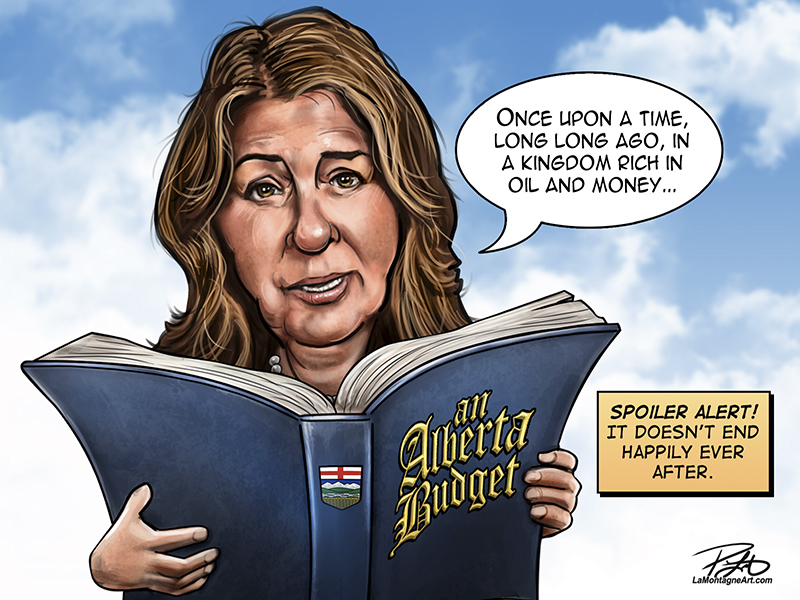 In 1998, while managing a waterslide facility at a hotel in Banff, I drew my first cartoon for the Banff Crag & Canyon. Many editorial cartoonists get into the profession because they’re political junkies who can draw. I liked to draw, and I figured I could learn to follow the news and politics if I had to.
In 1998, while managing a waterslide facility at a hotel in Banff, I drew my first cartoon for the Banff Crag & Canyon. Many editorial cartoonists get into the profession because they’re political junkies who can draw. I liked to draw, and I figured I could learn to follow the news and politics if I had to.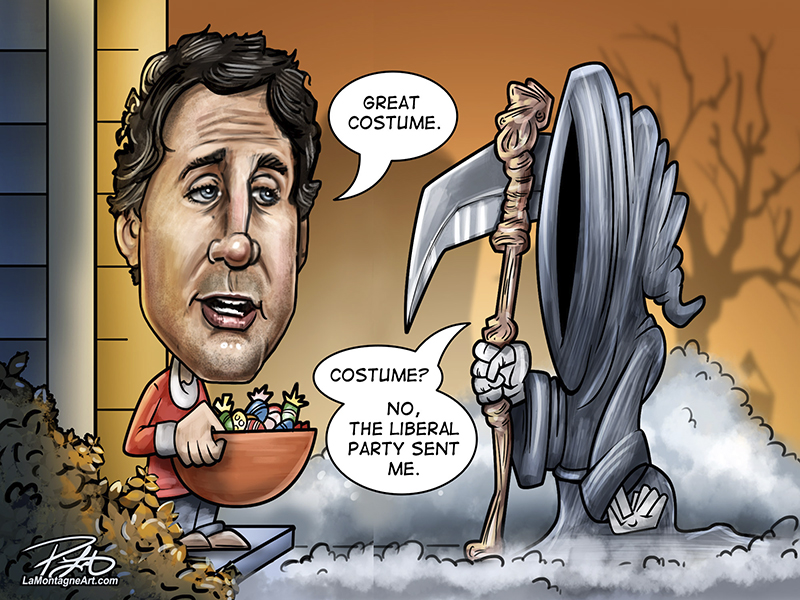 So, what’s a syndicated cartoon? I get that question a lot.
So, what’s a syndicated cartoon? I get that question a lot.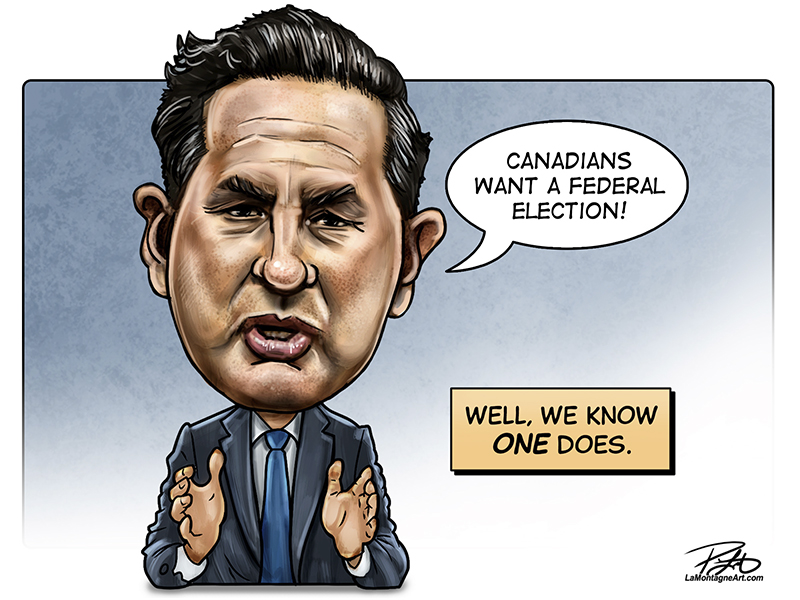 I’m most proud of the awards I received at Photoshop World Las Vegas in 2010 and 2014. The first year, I won the Illustration and Best in Show awards for some of my early animal paintings. That recognition was important to me because it was from an organization full of people I liked and respected. They were an encouraging group of talented artists and teachers, and they helped me become a better artist.
I’m most proud of the awards I received at Photoshop World Las Vegas in 2010 and 2014. The first year, I won the Illustration and Best in Show awards for some of my early animal paintings. That recognition was important to me because it was from an organization full of people I liked and respected. They were an encouraging group of talented artists and teachers, and they helped me become a better artist.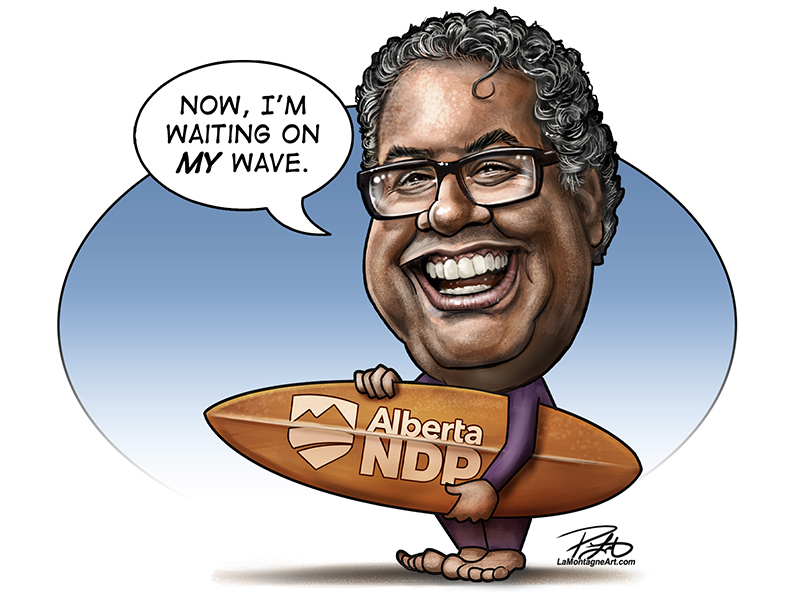 The
The 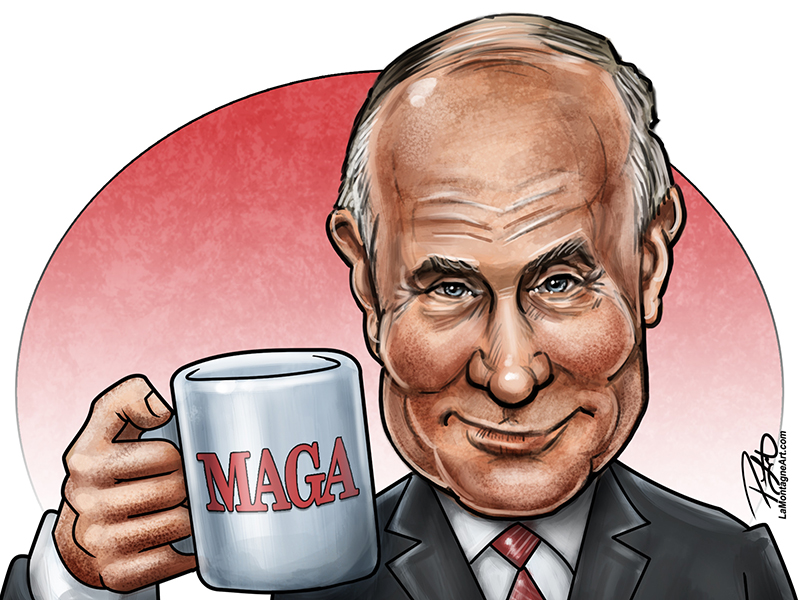 I’ve got some mixed feelings about this unexpected nomination. I’m pleased at the recognition, of course. It’s a bit of validation in a profession where I’ve often felt like an outsider.
I’ve got some mixed feelings about this unexpected nomination. I’m pleased at the recognition, of course. It’s a bit of validation in a profession where I’ve often felt like an outsider.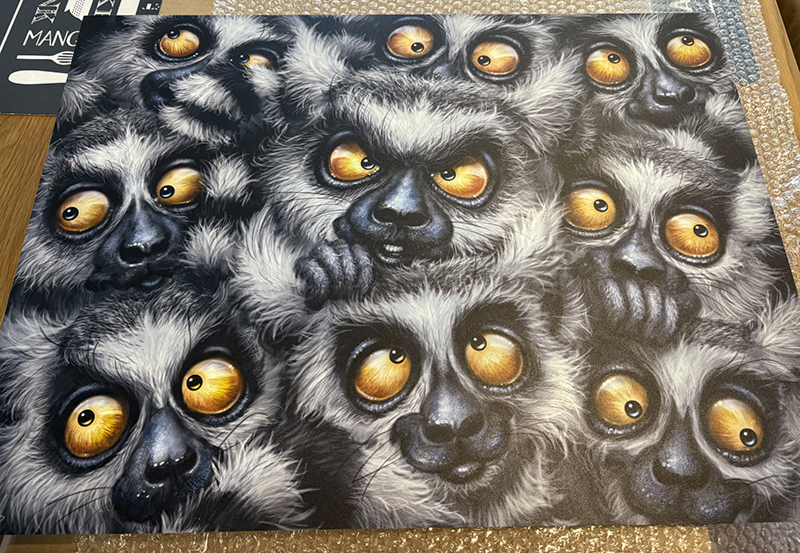 When I finished this Ringleader painting,
When I finished this Ringleader painting,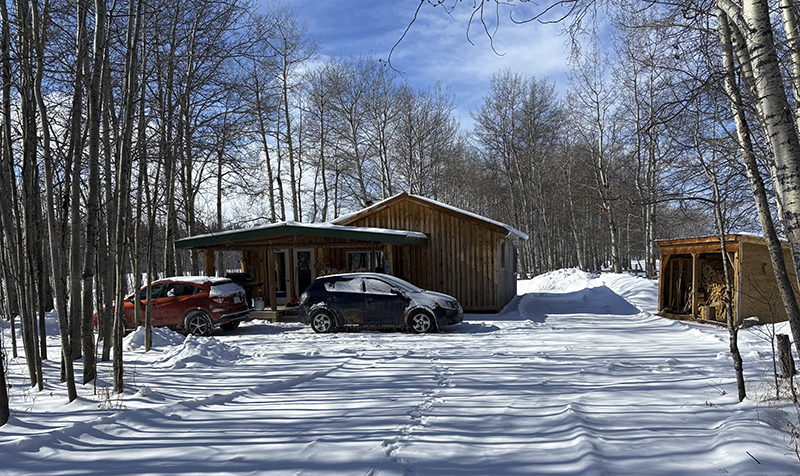 There was still plenty of snow on the ground, on the colder side of March, and we didn’t see any wildlife. But we did what greying old men like us usually do; played cards and games, went for walks around the property, napped and played guitar. This was a selfie I took for a text reply to Shonna one afternoon when she asked how we were doing.
There was still plenty of snow on the ground, on the colder side of March, and we didn’t see any wildlife. But we did what greying old men like us usually do; played cards and games, went for walks around the property, napped and played guitar. This was a selfie I took for a text reply to Shonna one afternoon when she asked how we were doing.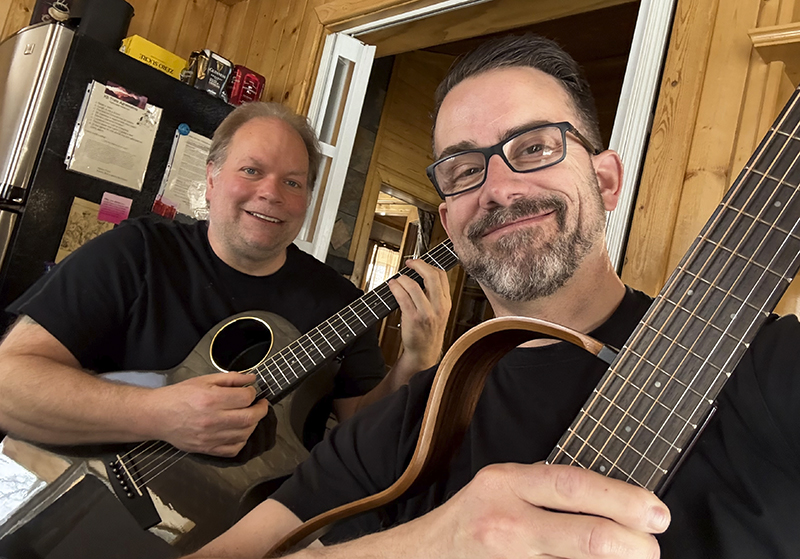 She complimented our usual black T-shirt matching ensembles. I told her I suspected she might be making fun of us, to which she replied, “Nailed it!”
She complimented our usual black T-shirt matching ensembles. I told her I suspected she might be making fun of us, to which she replied, “Nailed it!”
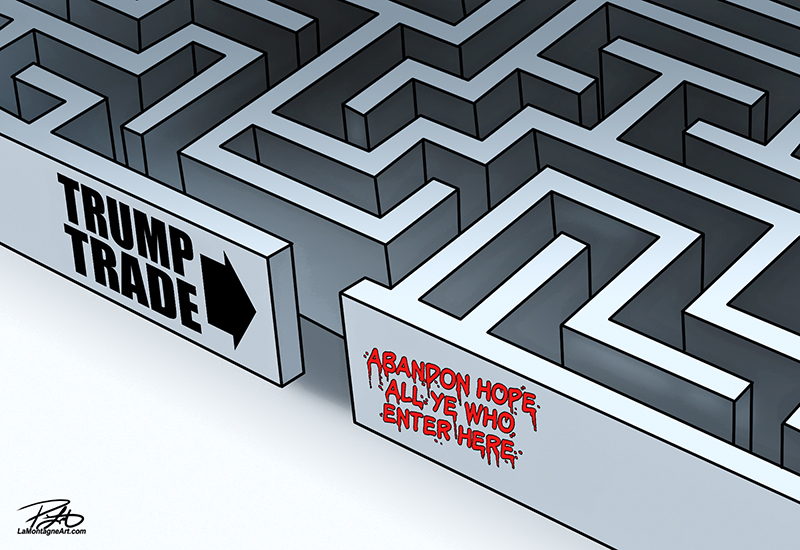 Canadians aren’t happy.
Canadians aren’t happy.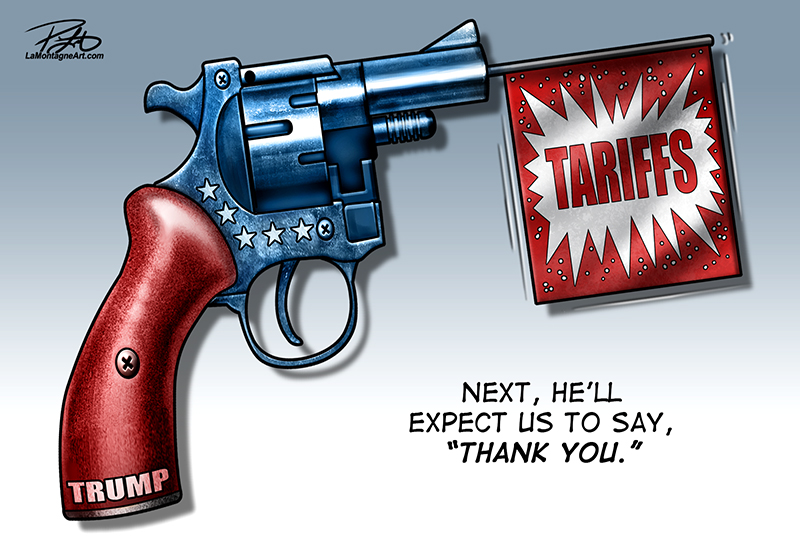
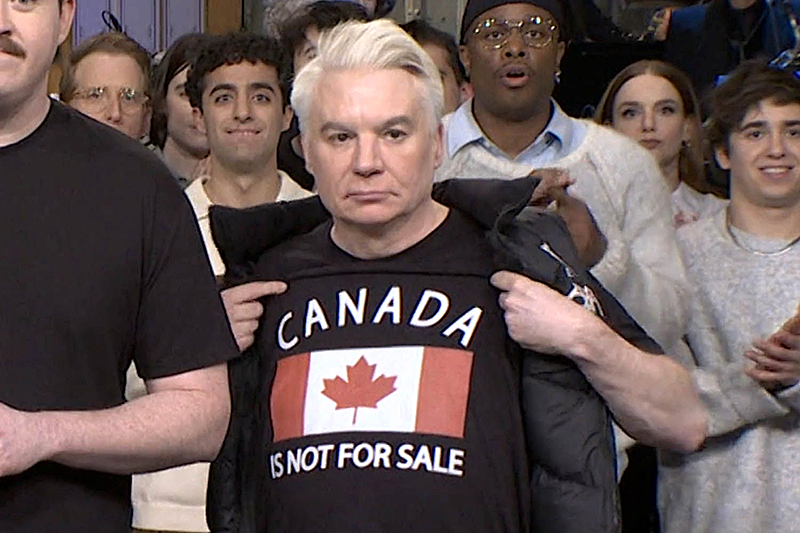
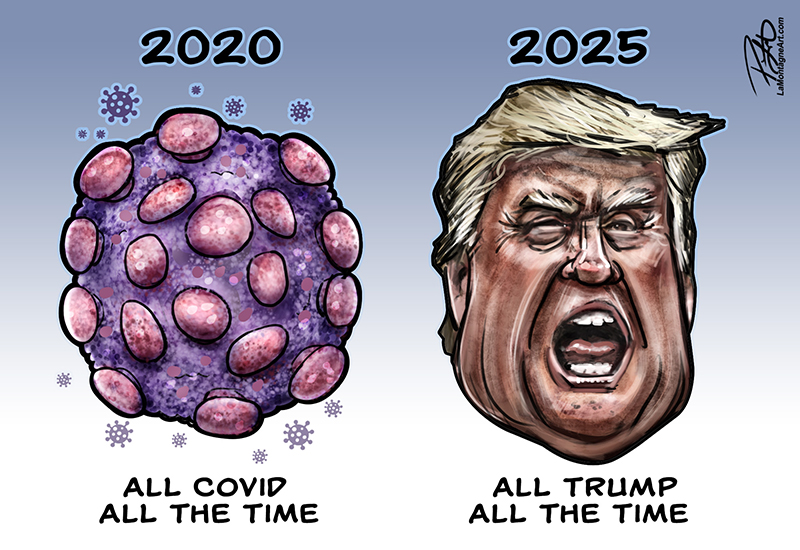
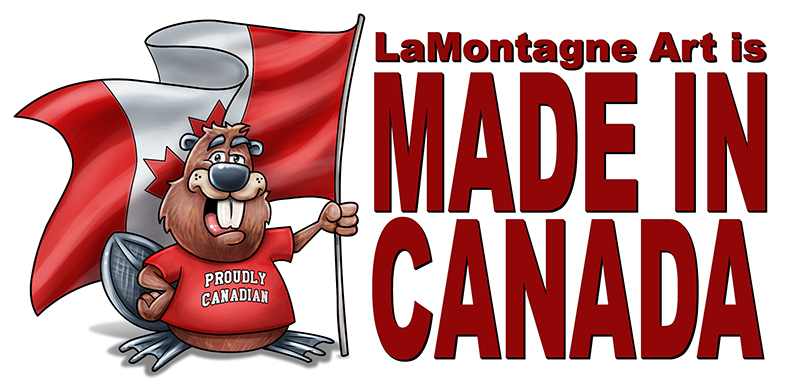
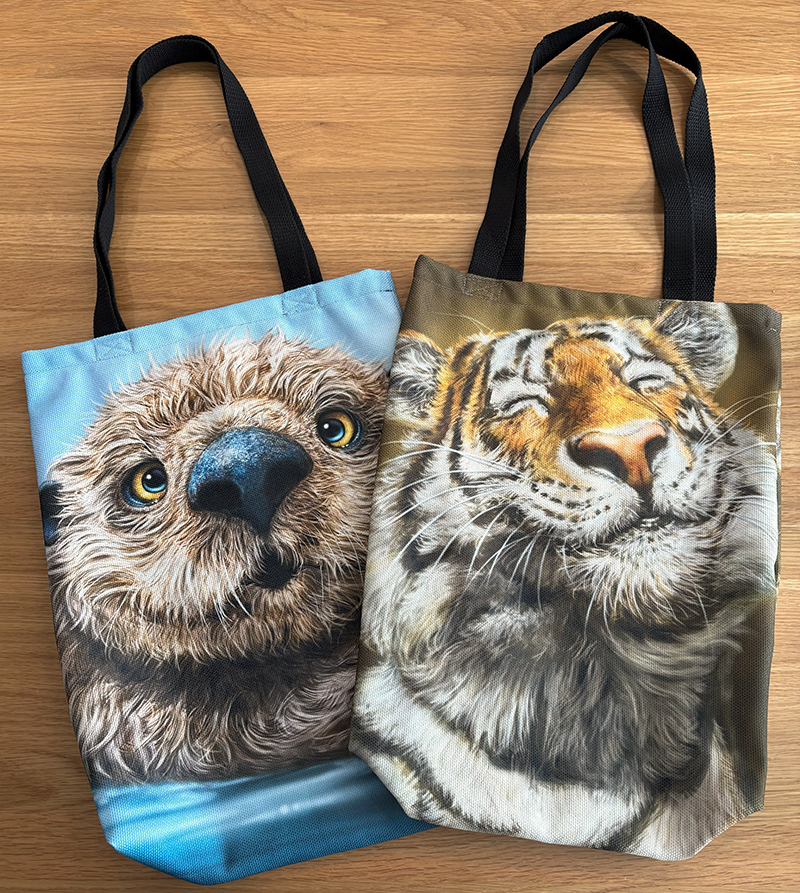 I have always strived for Made in Canada with the products I sell.
I have always strived for Made in Canada with the products I sell.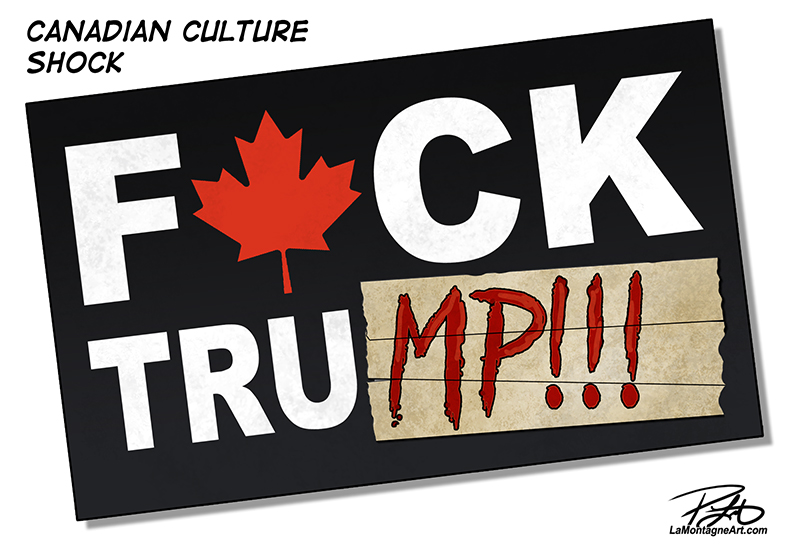

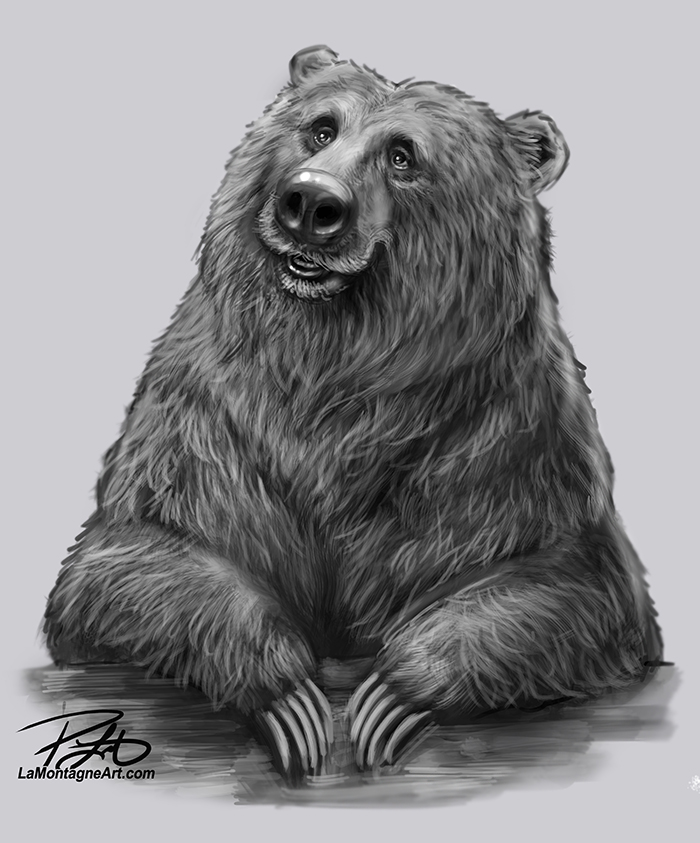 Over the past week, I’ve received a few
Over the past week, I’ve received a few 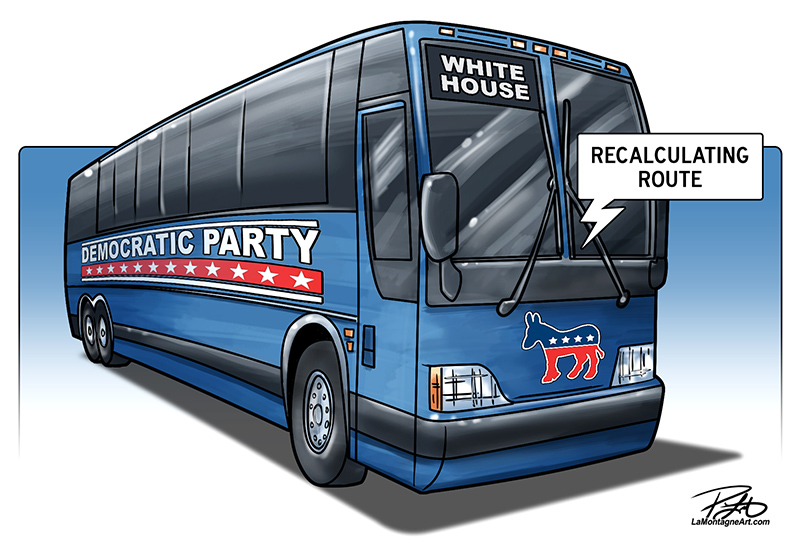 This past Sunday, I had drawn two cartoons in the morning and was going to paint all afternoon. Then President Biden announced he was no longer running for re-election, and suddenly, I had to draw a new cartoon for Monday morning. While drawing each cartoon takes a few hours or more, I first have to come up with the idea, which also takes time.
This past Sunday, I had drawn two cartoons in the morning and was going to paint all afternoon. Then President Biden announced he was no longer running for re-election, and suddenly, I had to draw a new cartoon for Monday morning. While drawing each cartoon takes a few hours or more, I first have to come up with the idea, which also takes time.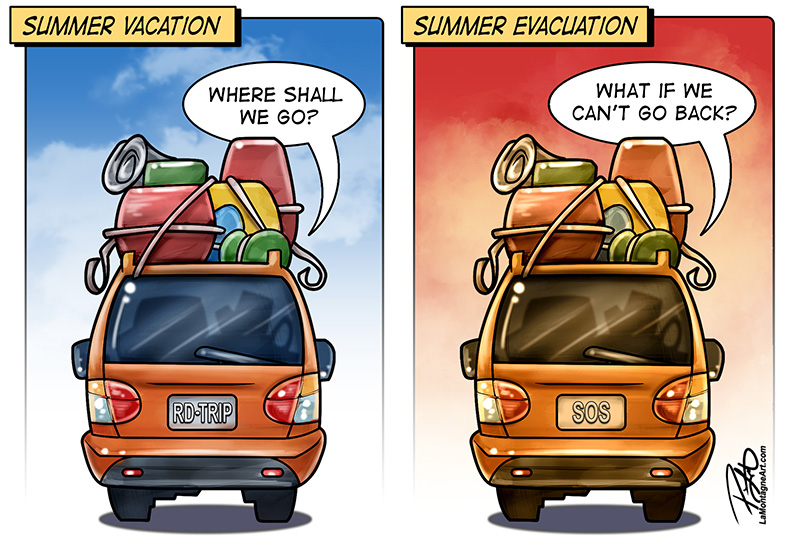 Adjusting course, I planned to paint all day Tuesday but woke to find out that the town of Jasper had evacuated for a wildfire. Suddenly, I had to scrap the cartoon I’d already drawn and sent Monday afternoon for the
Adjusting course, I planned to paint all day Tuesday but woke to find out that the town of Jasper had evacuated for a wildfire. Suddenly, I had to scrap the cartoon I’d already drawn and sent Monday afternoon for the 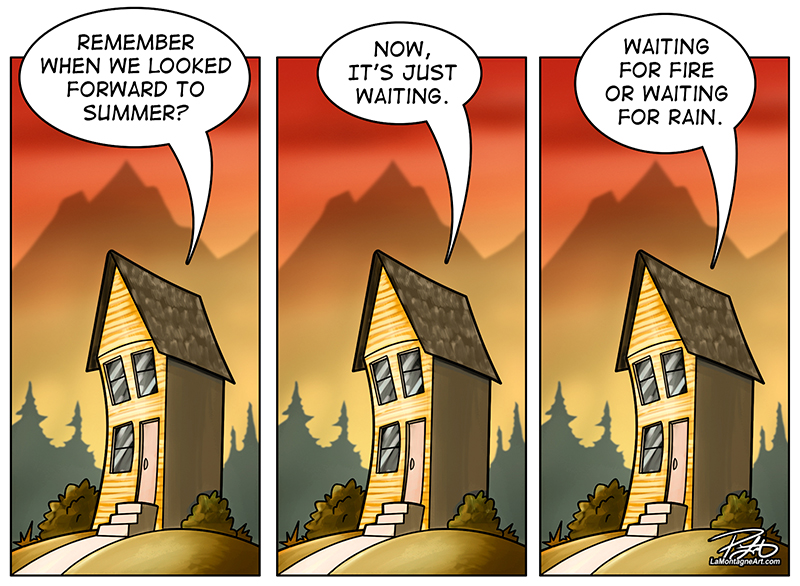 Having been through an evacuation in 2013 (water, not fire), and the odds are a little too good we may one day go through that again; I feel for those people. It’s a frightening thing to leave your home and not know if will be there when you get back. As the fire has breached the town of Jasper, and structures are burning, some people will lose everything. What makes it worse is when insensitive, small-minded keyboard warriors post stupid things like, “It’s only stuff.”
Having been through an evacuation in 2013 (water, not fire), and the odds are a little too good we may one day go through that again; I feel for those people. It’s a frightening thing to leave your home and not know if will be there when you get back. As the fire has breached the town of Jasper, and structures are burning, some people will lose everything. What makes it worse is when insensitive, small-minded keyboard warriors post stupid things like, “It’s only stuff.”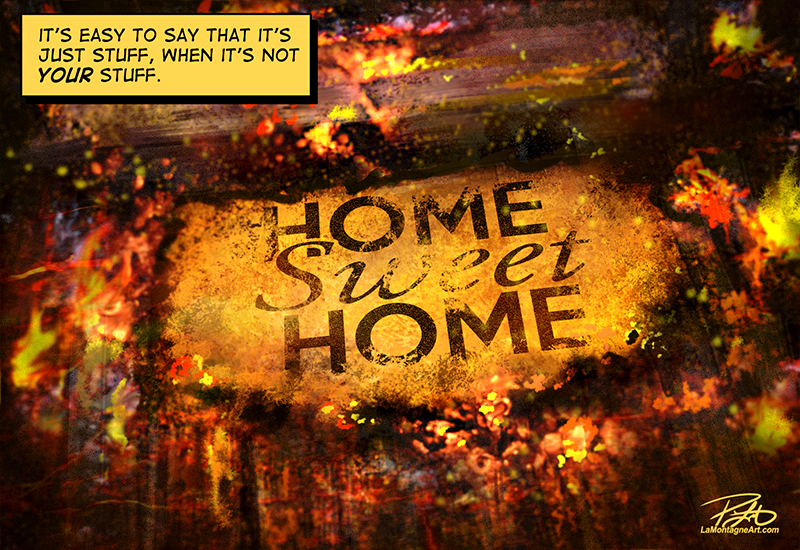 I have several paintings in progress, a few I expected to be done by now, which is frustrating. Because each features several animals, they take much longer, contributing to the feeling I’m not producing enough finished work.
I have several paintings in progress, a few I expected to be done by now, which is frustrating. Because each features several animals, they take much longer, contributing to the feeling I’m not producing enough finished work.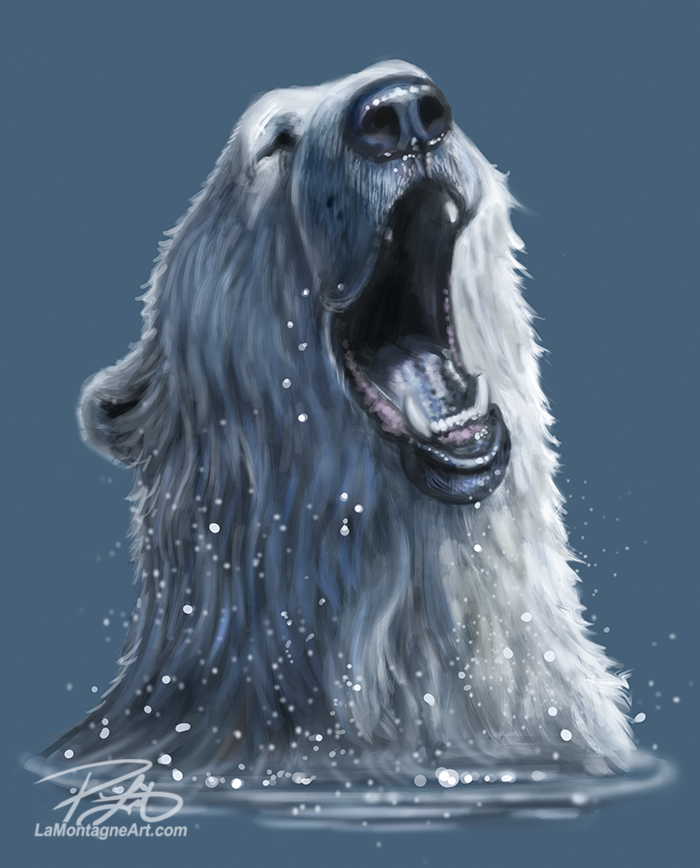 In the meantime, I hope you’re having a good summer despite the oppressive heat and wildfire smoke in some places. After a cool and comfortable rainy June, our July has sucked up all the moisture, and our brown grass and crispy trees could use some precipitation.
In the meantime, I hope you’re having a good summer despite the oppressive heat and wildfire smoke in some places. After a cool and comfortable rainy June, our July has sucked up all the moisture, and our brown grass and crispy trees could use some precipitation.

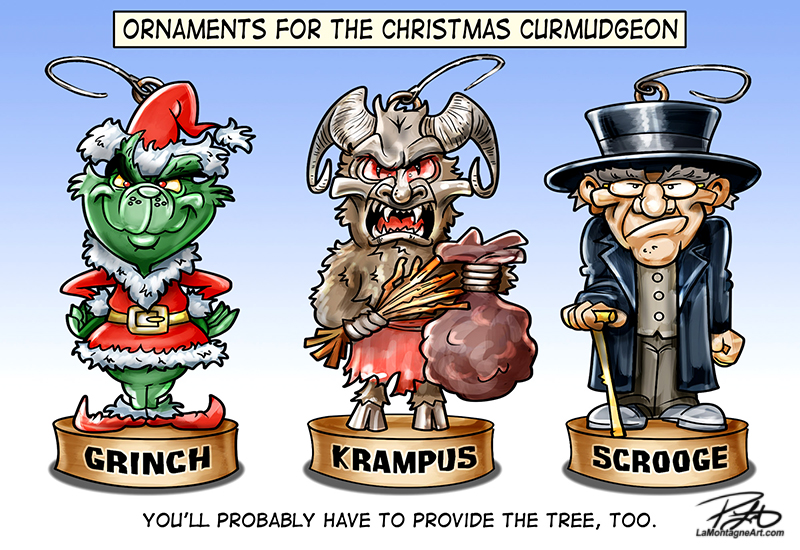 Near as I can tell, it was the seven years working in the tourism industry in Banff that exorcised the spirit of Christmas from this here cartoonist and painter of whimsical wildlife.
Near as I can tell, it was the seven years working in the tourism industry in Banff that exorcised the spirit of Christmas from this here cartoonist and painter of whimsical wildlife.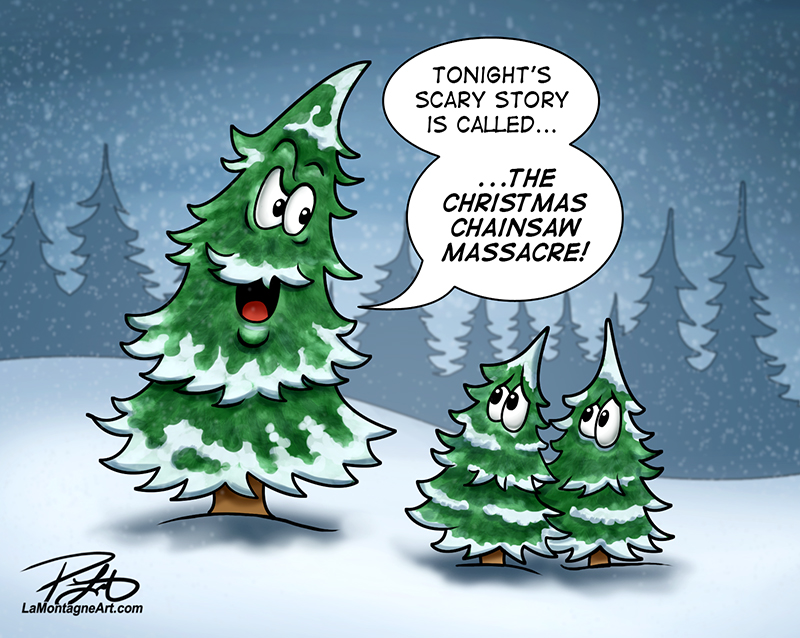 Shonna and I have not had a tree or decorations in more than twenty years. Aside from a few extra blankets on the couch, our home looks the same on December 25th as on July 25th. We don’t exchange gifts, and we don’t make a big meal.
Shonna and I have not had a tree or decorations in more than twenty years. Aside from a few extra blankets on the couch, our home looks the same on December 25th as on July 25th. We don’t exchange gifts, and we don’t make a big meal.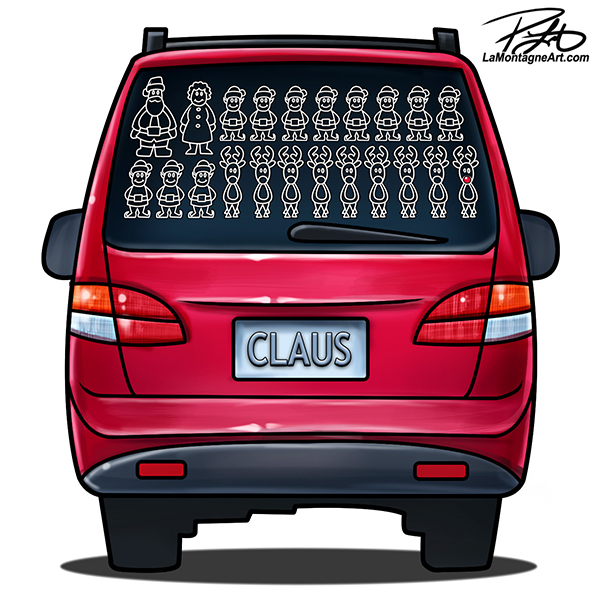 I welcomed the excuse not to travel. In the darkest month, with the best chance for the worst weather and most treacherous driving, while we’re all under peak stress, everybody hits the road at the same time. And if the highways close for a winter whiteout, and the RCMP tell you to stay home, well, that’s just too bad. Find a way; otherwise, you’ve ruined Christmas for everybody.
I welcomed the excuse not to travel. In the darkest month, with the best chance for the worst weather and most treacherous driving, while we’re all under peak stress, everybody hits the road at the same time. And if the highways close for a winter whiteout, and the RCMP tell you to stay home, well, that’s just too bad. Find a way; otherwise, you’ve ruined Christmas for everybody.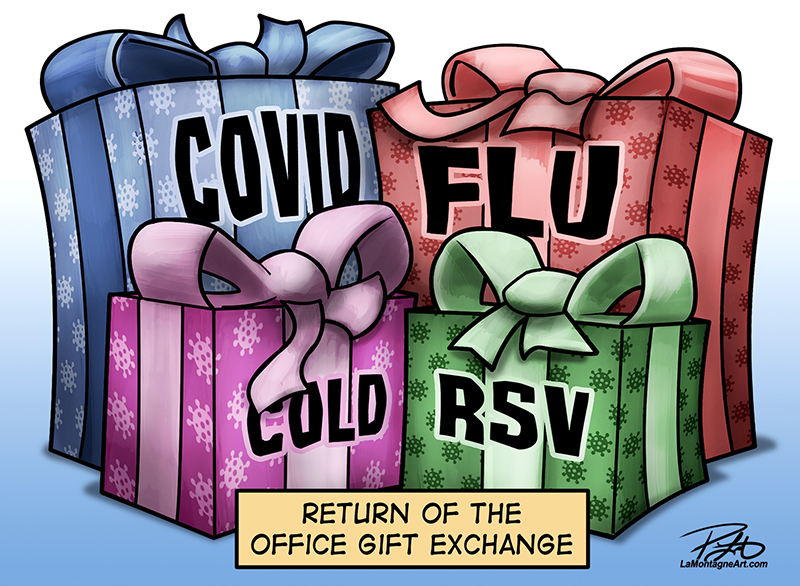 Even before the pandemic, ‘tis the season when we’re all contagious. So, we get together with as many people as possible, cram ourselves into crowded spaces, shake hands, hug and kiss and then eat a bunch of finger food.
Even before the pandemic, ‘tis the season when we’re all contagious. So, we get together with as many people as possible, cram ourselves into crowded spaces, shake hands, hug and kiss and then eat a bunch of finger food.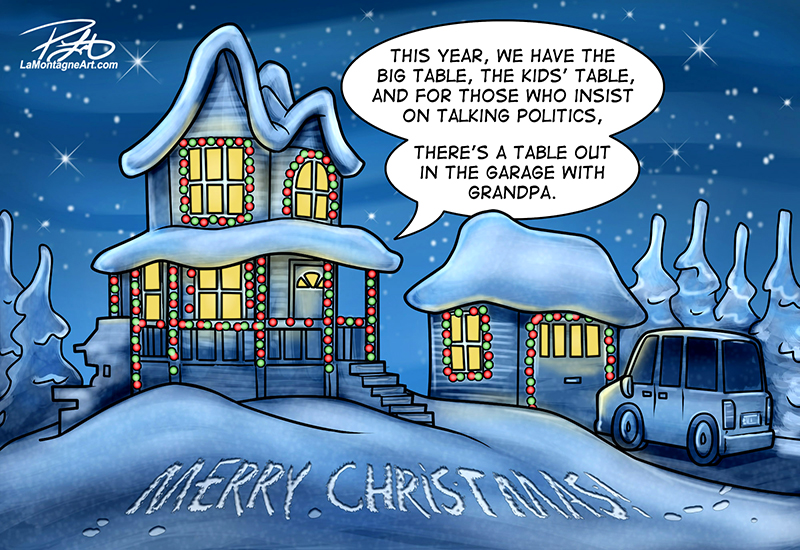 But here’s where it gets weird.
But here’s where it gets weird.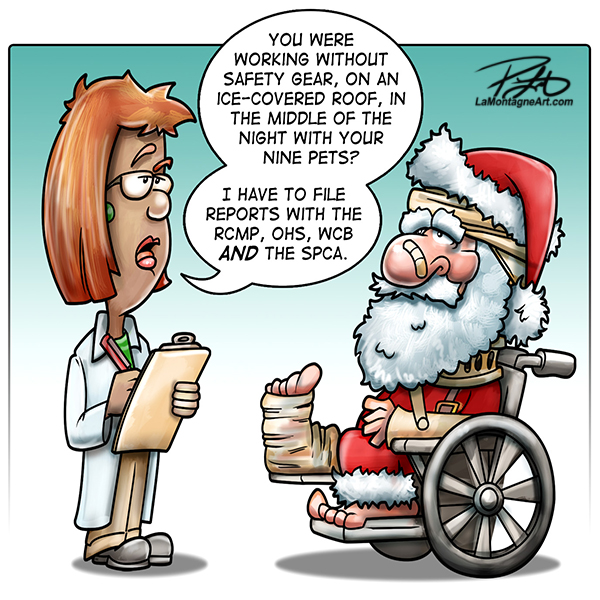 True, there’s always a cynical tone to these cartoons, making fun of the season and my issues with it, but that’s a pillar of the editorial cartoonist profession all year long. I usually come up with far too many ideas this time of year, more than I can draw in December.
True, there’s always a cynical tone to these cartoons, making fun of the season and my issues with it, but that’s a pillar of the editorial cartoonist profession all year long. I usually come up with far too many ideas this time of year, more than I can draw in December.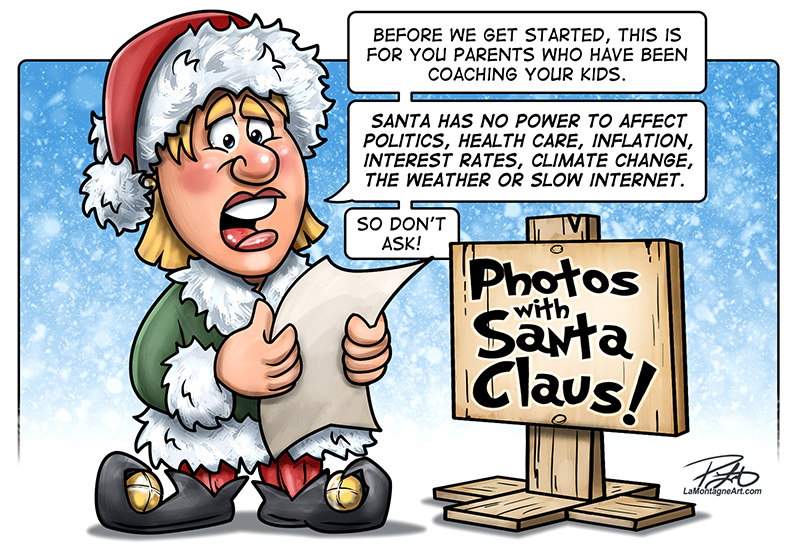
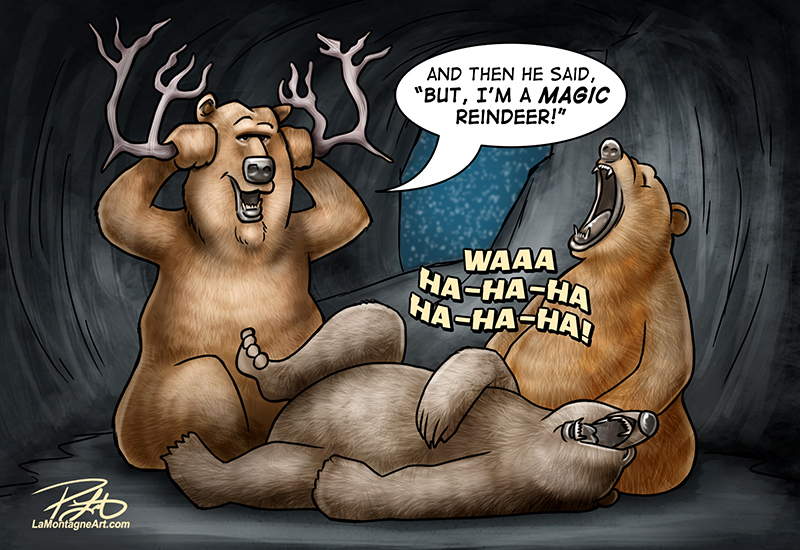

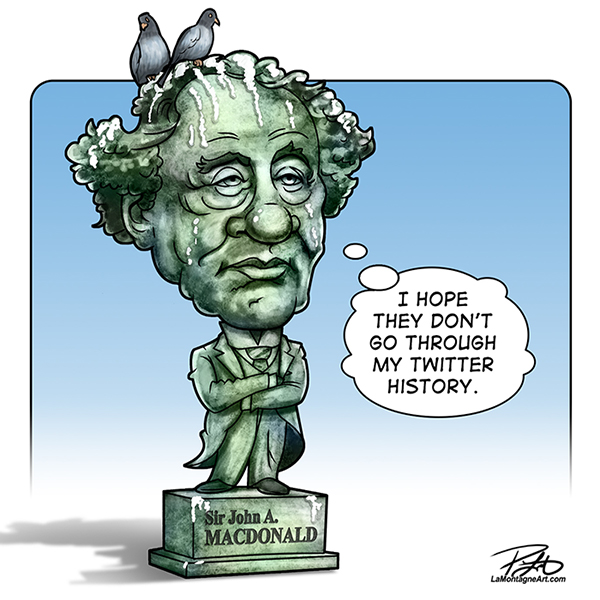
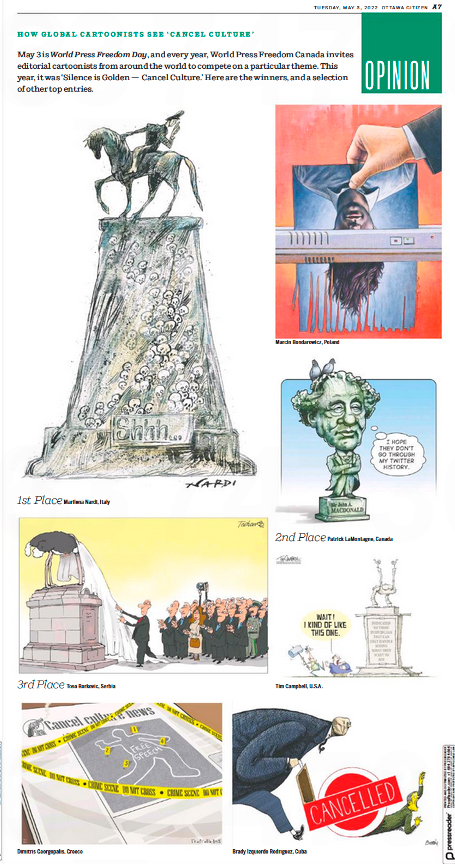 Today is World Press Freedom Day. As part of the observance of this reminder of the importance of journalistic freedom around the world,
Today is World Press Freedom Day. As part of the observance of this reminder of the importance of journalistic freedom around the world, 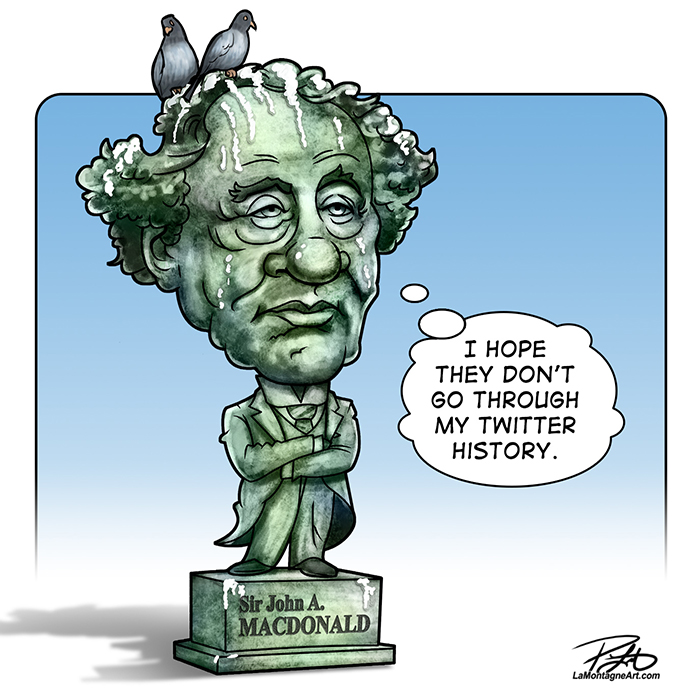 I enjoyed drawing this cartoon, though I learned long ago that what I think is clever and what other people like can be very different things. It’s a running gag between my wife and me that if I think a cartoon is particularly good, it won’t get printed anywhere. But if I send out one that meets the strict quality control metric of “good enough to meet my daily deadline,” that’s the one that gets printed and complimented the most.
I enjoyed drawing this cartoon, though I learned long ago that what I think is clever and what other people like can be very different things. It’s a running gag between my wife and me that if I think a cartoon is particularly good, it won’t get printed anywhere. But if I send out one that meets the strict quality control metric of “good enough to meet my daily deadline,” that’s the one that gets printed and complimented the most.
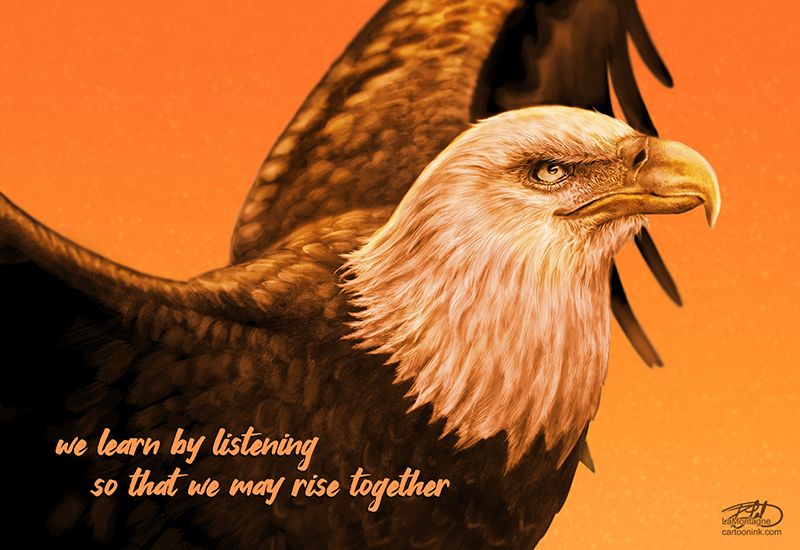 Early in this editorial cartoon profession, somebody once told me that editorial cartoons are supposed to make you laugh, think, and hopefully do both. I think it was Terry Mosher (Aislin).
Early in this editorial cartoon profession, somebody once told me that editorial cartoons are supposed to make you laugh, think, and hopefully do both. I think it was Terry Mosher (Aislin).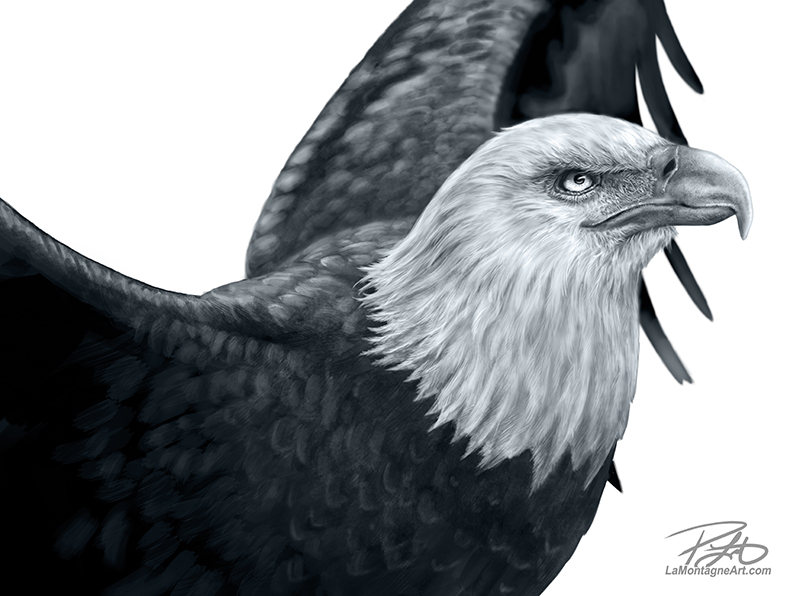 When I first created my animal art, I called them Totems but stopped the practice a few years ago.
When I first created my animal art, I called them Totems but stopped the practice a few years ago.